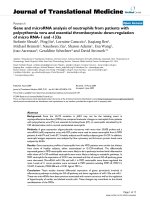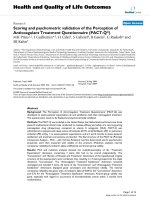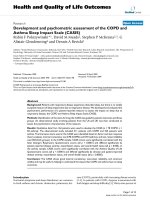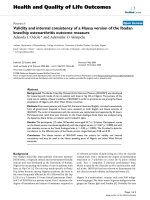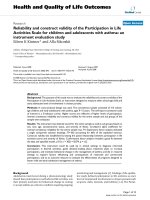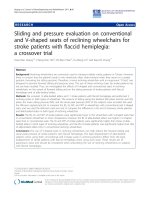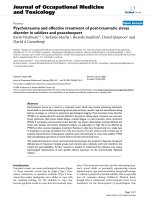Báo cáo hóa học: " Sliding and pressure evaluation on conventional and V-shaped seats of reclining wheelchairs for stroke patients with flaccid hemiplegia: a crossover trial" potx
Bạn đang xem bản rút gọn của tài liệu. Xem và tải ngay bản đầy đủ của tài liệu tại đây (753.86 KB, 8 trang )
RESEARCH Open Access
Sliding and pressure evaluation on conventional
and V-shaped seats of reclining wheelchairs for
stroke patients with flaccid hemiplegia:
a crossover trial
Hsiu-Chen Huang
1,2
, Cheng-Hsin Yeh
2
, Chi-Myn Chen
2
, Yu-Sheng Lin
2
and Kao-Chi Chung
1*
Abstract
Background: Reclining wheelchairs are commonly used to transport elderly stroke patients in Taiwan. However,
there is concern that the patient’s body in the w heelchair often slides forward when they return to a seated
position, increasing t he sitting pressure. Therefore, a novel reclining wheelchair with an ergonomic “V-Seat” was
designed to prevent forward sliding and pressure sores. The use of these reclining chairs by stroke patients has
not yet been studied. Thus, we investigated the effects of V-shaped and co nventio nal seats in reclining
wheelchairs on th e extent of forward sliding and on the sitting pressure of stroke patients with flaccid
hemiplegia and of able-bodied elders.
Methods: We recruited 13 able-bodied elders and 11 stroke patients with flaccid hemiplegia and performed 5
reclining cycles in both types of wheelchair. The amount of sliding along the backrest (BS) plane and the seat (SS)
plane, the mean sitting pressure (MP), and the sacral peak pressure (SPP) of the subjects were recorded. We used
the Wilcoxon signed-rank test to compare the BS, SS, MP, and SPP in wheelchairs with conventional and V-shaped
seats, and we used the Wilcoxon rank sum test to compare the differences in BS and SS between stroke patients
and able-bodied elders in both types of reclining wheelchair.
Results: The BS, SS, and SPP of stroke patients were significantly lower in the wheelchairs with V-shaped seats than
in conventional wheelchairs in most comparisons; however, the BS of able-bodied elders was higher in V-shaped
seats than in conventional seats. The SS and SPP of stroke patients were significantly higher than those of able-
bodied elders in both types of reclining wheelchair, and the BS of stroke patients was significantly higher than that
of able-bodied elders only in conventional reclining wheelchairs.
Conclusions: The use of V-shaped seats in reclining wheelchairs can help reduce the forward sliding and
sacral peak pressure of stroke patients with flaccid hemiplegia. The back displacement of able-bodied
subjects when using both conventional and V-shape seats in reclining positions differs from the back
displacement of stroke patients with flaccid hemiplegia when using such seats. These results are of
paramount value and should be considered when prescribing the use of reclining wheelchairs to subjects
with flaccid hemiplegia.
* Correspondence:
1
Institute of Biomedical Engineering, National Cheng Kung University, Tainan,
Taiwan
Full list of author information is available at the end of the article
Huang et al. Journal of NeuroEngineering and Rehabilitation 2011, 8:40
/>JNER
JOURNAL OF NEUROENGINEERING
AND REHABILITATION
© 2011 Huang et al; licensee BioMed Central L td. Th is is an Open Access article distributed under the terms of the Creative Comm ons
Attribution License ( whi ch permi ts unrestricted use, distribution, and reproduction in
any medium, provided the original work is properly cited.
Background
Reclining wheelchairs are commonly used to transport
stroke patients in Taiwan. For example, from 2007 to
2009, reclining wheelchairs accounted for 66.4% of spe-
cialized wheelchair prescriptions at our assistive devices/
technology center, and 58.5% of the reclining wheelchair
users were stroke patients [1]. Most reclining wheel-
chairs are light-weight, inexpensive, foldable, and com-
mercially available. Moreover, reclining wheelchairs
provide better trunk suppo rt [2] to stroke pat ients who
suffer from hemiplegia and poor sitting balance and/or
tolerance and also help reduce the sitting pressure [3] of
elderly stroke patients, who are susceptible to pressure
sores [4].
However, there is concern regarding the use of reclin-
ing wheelchairs by stroke patients. The patient’s body
often slides forward in the wheelchair when returning to
a seated position from a reclined position. This sliding
leads to a sacral sitting posture and results in increased
sacral shear stress, predisposing the patient to a sacral
pressure sore [5,6] and requiring caregivers to frequently
reposition their patients. Therefore, with the goal of pre-
venting forward sliding and pressure sores, a novel ergo-
nomic “V-Seat” has been designed. This seat “sinks” at
the backrest at a downward angle of up to 20 degrees,
whereas the backrest itself reclines up to 160 degrees
(Figure 1). However, the use of these chairs by stroke
patients has not yet been studied.
We investigated the effects of V-shaped and conven-
tional seats in reclining wheelchairs on the forward slid-
ing and sitting pressure of stroke patients with flaccid
hemiplegia and able-bodied elders. We hypothesized
that 1) able-bodied elders and flaccid hemiplegic
patients have different mechanisms of forward sliding
and interface pressure when using the V-shaped seats,
and 2) the “ V-Seat” reclining wheelchair can reduce the
degrees of forward sliding and sitt ing pressure of stroke
patients with flaccid hemiplegia.
Methods
Subject description
We recruited able-bodied elders and non-ambulatory
stroke patients with flaccid hemiplegia to investigate the
difference between whe elchairs with conventional and
V-shaped seats. To minimize anthropometric differences
among the subjects, the inclusion cri teria were a weight
of 40-70 kg, a body length of 140-170 cm, and an age of
60-85 years. Stroke patients who had conscious ness dis-
turbances, severe cognitive deficits (e.g., becoming agi-
tated or disobedient), aphasia, or bilateral hemiplegia
were excluded from this study. The demographic data of
the study subjects were recorded.
Equipment and materials
We used wheelchairs with conventional and V-shaped
seats in this study (Figure 2). The wheelchair with a V-
shaped seat (16” Model, KARMA MEDICAL PRO-
DUCTS CO., LTD.) features an anti-sliding V-shaped
seat that “sinks” to a maximum downward angle of 20
degrees, whereas the backrest can recline up to 160
degrees. The conventional wheelchair was also 16” wide
(KARMA MEDICAL PRODUCTS CO., LTD.). Both
types of wheelchairs were equipped with the same
backrest, legrest and foam cushions to ensure that the
seat mechanics were the only difference between the
wheelchairs. To specifically measure the effect of V-
shaped seats versus conventional seats, the armrests
were removed for this study. A sensor system (X3
PX100:36.36.0 2, XSENSOR) was used to collect pressure
data at the seat interfaces. The sensor system was a flex-
ible pad with a 46 cm × 46 cm sensing area containing
1296 (36 × 36) sensing points. The measured pressure
Figure 1 The comparison between con ventional reclining wheelchairs, reclining wheelchairs with V-shaped seats, and tilt-in-space
wheelchairs (Left to right). The rear halves of the V-shaped seat and the tilt-in-space seat are similar, but the V-shaped seat differs from the
traditional tilt-in-space seat in the following ways: 1) The front half of the seat is fixed, 2) The degree of downward inclination (maximum of 20
degrees) is less than that of the tilt-in-space seat, and 3) The seat-to-back angle varies.
Huang et al. Journal of NeuroEngineering and Rehabilitation 2011, 8:40
/>Page 2 of 8
range was 10-200 mmHg. The accuracy of the pressure
measurement was ± 10% of the full scale.
Experimental protocol
At the beginning of testing, the geometries of both
types of wheelchair were adjusted to a seat back angle
(SBA) of 100 degrees and a legrest angle (LRA) of 120
degrees (Figure 3). The subjects randomly selected one
of the wheelchairs without knowing its type, as the
wheelchairs look almost identical. Each subject was
asked to sit comfortably on the wheelchair, and their
starting position was marked to allow measurements of
the sagittal motion of his or her body. Four anatomical
markers (bilateral acromion and greater trochanter)
and four wheelchair markers on both sides of the
backrest and seat were used. Five reclining cycles were
performed by reclining the SBA from 100 to 150
degrees and then back to 100 degrees at a constant
rate (Figure 2). If the subjects could not continue sit-
ting, due to intolerance or to t he danger of sliding out
of the wheelchair, the experiment was stopped for
safety reasons. Between each cycle, the subjects were
asked to relax for a one-minute break. The geometric
and mechanical data were measured by a well-trained
physical therapist.
Geometric and mechanical parameters
The geometric parameters include the degrees of sliding
along the backrest (BS) and sliding along the seat (SS),
which are standard measures also used by Aissaoui et al.
[7] and are defined as follows (Figure 3):
BS =[(V
i
− V
n
)
left
+(V
i
− V
n
)
right
]/
2
SS =[(H
i
− H
n
)
left
+(H
i
− H
n
)
ri
g
ht
]/2
where V
i
and V
n
are the distances perpendicular to
the backrest support plane between the backrest marker
and the acromion marker in its initial position (i) and
after a number of cycles (n). H
i
and H
n
are the distances
perpendicular to the seat support plane between the seat
marker and the trochanter marker in its initial position
Inclined angle
V-shape
100
̓
150̓
0
̓
One cycle
Inclined angle
V-shape
Inclined angle
V-shape
0
̓
One cycle
0
̓
One cycle
Figure 2 The difference in seat mechanics between wheelchairs with conventional (Right) and V- shaped seats (Left). Cyclic tests were
performed by reclining the seat back angle (SBA) from 100 to 150 degrees and then back to 100 degrees.
V
n
H
n
LRA= 120°
BS= [(V
i
-V
n
)
left
+(V
i
-V
n
)
right
]/2
SS= [(H
i
-H
n
)
left
+(H
i
-H
n
)
right
]/2
SBA
+
+
B
S
SS
Figure 3 The definition of sliding along the backrest (BS) and
sliding along the seat (SS). Vn and Hn were recorded when the
seat back angle (SBA) was at 100 degrees. The hollow circle and
solid circle represent the anatomical markers and wheelchair
markers, respectively.
Huang et al. Journal of NeuroEngineering and Rehabilitation 2011, 8:40
/>Page 3 of 8
(i) and after a number of cycles (n). The sliding along
the backrest (BS) and along the seat (SS) were calculated
by averaging the values measured on the left and right
sides to represent the midline sagittal s liding. In ad di-
tion, mechanical parameters were recorded to evaluate
the pressure distribution at the seat interface. These
parameters include the mean pressure (MP) in the total
contact area (> 5.2 mmHg) and the sacral peak pressure
(SPP).
Statistical methods
The results are presented as the means ± standard
deviations, and comparisons of the BS, SS, MP, and SPP
measured in wheelchairs with conventional and V-
shaped seats were made using the Wilcoxon signed-rank
test. The Wilcoxon rank sum test was used to compare
the difference in BS and SS between stroke patients
with flaccid hemiplegia and able-bodied elders in both
types of reclining wheelchairs. This difference indicates
the effect of hypotonicity on postural control. All statis-
tical tests were conducted using the Statistical Package
for the Social Sciences (SPSS) 15.0 for Windows with a
two-tailed significance level of 0.05.
Ethical issues
The study’s protocol was approved by the institutional
review board of the Chia-Yi Christian Hospital. All sub-
jects provided informed consent.
Results
Demographics
Twenty-five elders participated in this study. The data
from one subject is not included due to an extremely
unstable sitting condition. Of the 24 par ticipating sub-
jects, 10 were men and 14 were women. Of the 11
patients with flaccid hemiplegia, 7 suffered from left-
sided hem iplegia and 4 from right-sided hemiplegia. No
significant differences between the able-bod ied and flac-
cid hemiplegic groups were found in age, weight, or
height (Table 1).
Geometric outcomes (BS and SS)
Table 2 shows the variations in BS between the subject
groups and between the wheelchair types. In general,
the average BS values of these groups were positive,
indicating that the median location of the bilateral
acromion is displaced downward during the reclining
cycles. In the conventional wheelchairs, the BS of the
flaccid hemiplegic group was significantly higher than
that of the able-bodied group over the first 3 cycles,
whereas no significant differences were found between
the two groups in wheelchairs with V-shaped seats.
For the flaccid hemiplegic subjects, wheelchairs with
V-shaped seats caused less BS than the conventional
wheelchairs at a statistically significant level after the
third cycle, with only a marginal difference after the
first cycle. For able-bodied subjects, the BS in wheel-
chairs with V-shaped seats was significantly higher
than in conventional reclining wheelchairs after the
fifth cycle.
Table 3 shows the variations in sliding along the seat
plane (SS) between the subject groups an d the wheel-
chair types. Positive values of SS indicate forward displa-
cements of the median of the greater trochanter along
the seat plane measured on both sides, whereas negative
values indicate rearward displacements from the initial
position. In both types of wheelchairs, flaccid hemiplegic
subjects slid significantly further forward than able-bod-
ied subjects (except after cycle 4, which may be due to
the small sample size of the flaccid hemiplegic group).
Flaccid hemiplegic subjects slid significantly less further
forward in V-shaped seat wheelchairs than in conven-
tional wheelchairs over the first 3 cycles, whereas for
able-bodied subjects, there were signi ficant differences
between the two types of wheelchairs except after the
first cycle, and there was only a marginal difference
after cycle 4.
Figure 4 shows the distributions of BS and SS of flac-
cid hemiplegic subjects in both wheelchair types. Some
data points could not be collected after the third cycle,
as some of the flaccid hemiplegic subjects could not
participatefortheentireexperimental procedure. This
missing data results in a small sample size and reduces
the statistical power. The ranges of BS were between
-16 and 40 mm in the wheelchairs with V-shaped seats
and between -2 and 94 mm in the conventional wheel-
chairs. The ranges of SS were between -8 and 35 mm in
the wheelchairs with V-shape seats and between 0 and
120 mm in the conventional wheelchairs. Overall, the
ranges of sliding along both the backrest and seat planes
were larger in the conventional wheelchairs than in the
wheelchairs with V-shaped seats.
Table 1 Demographics of able-bodied and flaccid
hemiplegic subject groups
Group Able-bodied Flaccid P
Gender Male 5 5 > 0.95
Female 8 6
Age Mean 71.9 72.6 0.865
(years) SD 5.8 8.4
Weight Mean 62.7 58.4 0.207
(Kg) SD 6.6 10.7
Height Mean 160.0 157.5 0.459
(cm) SD 7.2 8.8
Huang et al. Journal of NeuroEngineering and Rehabilitation 2011, 8:40
/>Page 4 of 8
Mechanical outcome (MP, SPP)
The comparisons of the mean seat pre ssures of the sub-
ject groups and wheelchair types are shown in Table 4.
Overall, no significant differences were found among the
groups. The mean pressure slightly increased with the
number of compl eted reclining cycles and varied from
35.8 to 40.0 mmHg.
Table 5 shows that subjects with flaccid hemiplegia
were susceptible to higher sacral peak pressures than
able-bodied subjects in both types of wheelchair, and
significant differences were found after every cycle (mar-
ginal difference after cycle 4 in conventional wheel-
chairs). For subjects with flaccid hemiplegia, the sacral
peak pressures measured in the initial measurement and
after the first 3 cycles were significantly lower in the
wheelchairs w ith V-shaped seats than in conventional
wheelchairs (marginal significance after cycle one). For
able-bodied subjects, the SPP was less in the wheelchairs
with V-shaped seats than in the conventional wheel-
chairs; this difference was apparent at the initial mea-
surement and after cycle 4, and there was a marginal
difference after cycle one.
Discussion
Our results indicate that stroke patients with flaccid
hemiplegia are more vulnerable to forward sliding along
the seat plane and are, therefore, subject to higher sacral
peak pressures (SPP) than able-bodied elders in both
types of wheelchairs. V-shaped seats noticeably reduce
the forward sliding of stroke patients and also tend to
decrease forward sliding in able-bodied elders, indicating
that V-shaped seats can help prevent wheelchair users
from sacral sitting. Moreover, these seats can also help
prevent the development of sacral pressure sores, as evi-
denced by the significantly lower SPP measured in the
wheelchairs with V-shaped seats compared to the con-
ventional type.
Proper seating/positioning of non-ambulatory stroke
patients with flaccid hemiplegia who need to remain
seated for long periods of time is difficult to achieve
because the patients o ften have poor trunk control and
poor sitting tolerance. Reclining wheelchairs are com-
monly used for non-ambulatory stroke patients with
flaccid hemiplegia in hospital settings and nursing facil-
ities because they serve not only as transportation tools
but also as assistive devices for better positioning in
long-term care. Our study provides important data
regarding forward sliding and sitting pressure in reclin-
ing wheelchairs for stroke patients, and these data may
provide valuable information for selecting the appropri-
ate reclining wheelchair.
Previous research on wheelchair design recruited able-
bodied subjects to collect data about seating position,
but these results cannot be directly applied to patients
with abnormal muscle tone. For example, Stinson et al.
[8] recruited healthy participants to evaluate the effects
of repositioning and sitting on the co nsiste ncy of inter-
face pressure. MacDonald et al. [9] and Kirby et al. [10]
used able-bodied participants to compare the mean
pressure and the wheelchair handling skills of a tilt-in-
Table 2 Measurement of sliding along the backrest plane by subject groups and wheelchair (WC) types
Cycles V-seat WC Conventional WC Flaccid Able-bodied
Flaccid Able-bodied p Flaccid Able-bodied p V-seat vs. Conv. p V-seat vs. Conv.p
n Mean SD n Mean SD n Mean SD n Mean SD Diff. Diff.
1 11 8.3 12.2 13 11.3 8.7 0.691 11 20.6 15.2 13 4.0 8.2 0.005* -12.3 0.068 7.4 0.087
2 11 16.9 13.4 13 12.9 11.4 0.494 11 32.6 22.5 13 5.0 11.3 0.001* -15.6 0.110 7.9 0.108
3 9 15.8 15.0 13 12.7 11.7 0.357 8 41.6 27.0 13 7.5 14.0 0.002* -25.8 0.036* 5.2 0.248
4 5 12.2 5.6 13 13.3 13.6 0.924 4 33.6 23.5 13 9.0 11.1 0.130† -21.4 0.465 4.3 0.263
5 4 14.6 9.3 13 13.9 12.9 0.956 4 33.9 24.3 13 6.5 11.4 0.130† -19.3 > 0.95 7.5 0.043*
*p < 0.05 †The nonparametric tests lack statistical power with small sample size.
Table 3 Measurement of sliding along the seat plane by subject groups and wheelchair (WC) types
Cycles V-seat WC Conventional WC Flaccid Able-bodied
Flaccid Able-bodied p Flaccid Able-bodied p V-seat vs. Conv. p V-seat vs. Conv. p
n Mean SD n Mean SD n Mean SD n Mean SD Diff. Diff.
1 10 6.6 8.7 13 -1.7 5.4 0.011* 10 25.4 19.5 13 2.4 13.7 0.002* -18.8 0.007* -4.1 0.286
2 10 9.2 9.7 13 -3.7 7.5 0.002* 10 45.9 28.8 13 4.7 12.7 < 0.001* -36.7 0.003* -8.4 0.012*
3 8 12.1 12.5 13 -3 7.8 0.004* 8 54.8 30.6 13 4.4 14.7 < 0.001* -42.7 0.012* -7.4 0.045*
4 5 7.7 8.9 13 -2.1 8.5 0.117 4 44.6 13.4 13 3.9 13.2 0.002* -36.9 0.068† -6 0.055
5 4 13.8 9.9 13 -2.2 8.6 0.023* 4 54.6 16.7 13 6.4 16 0.002* -40.8 0.109† -8.6 0.006*
*p < 0.05 †The nonparametric tests lack statistical power with small sample size.
Huang et al. Journal of NeuroEngineering and Rehabilitation 2011, 8:40
/>Page 5 of 8
space wheelchair and a manual wheelchair equipped
with a new rear anti-tip device from the perspectives of
the caregiver and the user. Aissaoui et al. [11] used
able-bodied subject s to compare the kinematic effects of
conventional and compensatory legrests. However, these
results still need to be verified for disabled subjects
before they can be adopted into clinical practice. As
reported above, when comparing the differences in back
displacement caused by conventional and V-shaped
seats at reclining positions, the BS of able-bodied s ub-
jects was found to differ from that of stroke patients
with flaccid hemiplegia. Although many researchers
study seating in wheelchairs for disabled people [12-14],
there is very little research focused on stroke patients
with flaccid hemiplegia. This paper is the first reported
study that investigates the effect of V-shaped seats on
the positioning of stroke patients with hypotonicity. In
comparison to the 4-bar linkage [15], which was also
designed to prevent patients from sliding in reclining
wheelchairs and which proved to be effective in redu-
cing back displacement for quadriplegic subjects, the V-
shaped seat is a simpler yet effective design. Reclining
wheelchairs with V-shaped seats are foldable, light-
weight, easy to push, and inexpensive.
Thi s study also demonstrates the trends of incremen-
tal forward sliding and increasi ng sacral sitting pressure
when stroke patients repeatedly recline in both wheel-
chair types, indicating the importance of repositioning
Figure 4 The distribution of sliding along the backrest and seat planes by flaccid hemiplegic subjects. BS and SS represent the sliding
along the backrest (BS) plane and the sliding along the seat (SS) plane, respectively.
Table 4 Mean pressure (MP, mmHg) measurements by subject groups and wheelchair (WC) types
Cycles V-seat WC Conventional WC Flaccid Able-bodied
Flaccid Able-bodied p Flaccid Able-bodied p V-seat vs. Conv. p V-seat vs. Conv. p
n Mean SD n Mean SD n Mean SD n Mean SD Diff. Diff.
0 11 36.1 3.9 13 36.7 1.9 0.277 11 35.8 3.2 13 36.3 2.3 0.776 0.3 0.859 0.4 0.311
1 11 37.2 3.7 13 38.3 1.8 0.186 11 37.1 2.9 13 38.0 2.0 0.277 0.1 0.959 0.3 0.507
2 11 37.3 3.7 13 38.9 1.9 0.055 11 38.2 3.0 13 38.6 2.0 0.910 -0.8 0.182 0.3 0.552
3 9 38.2 3.5 13 39.4 1.8 0.051 8 38.8 3.2 13 39.1 1.9 0.916 -0.7 0.401 0.3 0.600
4 5 37.5 1.6 13 39.7 2.1 0.075 4 37.0 2.2 13 39.3 2.0 0.130 0.5 0.715 0.4 0.507
5 4 38.0 2.1 13 39.9 2.0 0.163 4 37.2 2.0 13 39.7 2.0 0.130 0.7 1.000 0.2 0.754
Huang et al. Journal of NeuroEngineering and Rehabilitation 2011, 8:40
/>Page 6 of 8
after returning the patients to an upright position even
while using a wheelchair with a V-shaped seat. More-
over, we found that the overall peak pressure was often
located on either the left or right side of subjects with
flaccid hemiplegia, who were prone to sit with pelvic
obliquity. The V-shaped seat mechanism alone could
not lessen the high ischial pre ssure on patients who
tended to sit on one side, possibly contributing to the
insignificant difference in the mean pressures measured
in the two types o f wheelchair. Therefore, when seating
a subject with flaccid hemiplegia, the pressure on the
side to which the subject leans should be taken into
account.
Conclusions
In conclusion, V-shaped seats in reclining wheelchairs
can help reduce forward sliding and the p eak sacral
pressure of stroke patients with flaccid hemiplegia,
who are subject to m ore forward sliding and sacral
pressure in reclining wheelchairs than able-bodied
elders. V-shaped seats in reclining wheelchairs are a
simple and effective design to help prevent the user
from experiencing sacral sitting. The back displac e-
ment of able-bodied subjects when using both conven-
tional and V-shape d seats in reclining positions differs
from that of stroke patients with flaccid hemiplegia
when using such seats. This paper is the first study to
investigate the effect of V-shaped seats on the posi-
tioning of hemiplegic patients with hypotonicity. The
results are of paramount value and should be consid-
ered when prescribing the use of reclining wheelchairs
to subjects with flaccid hemiplegia.
Acknowledgements and funding
The authors acknowledge the financial support from the Chia-Yi Christian
Hospital in Taiwan for this research (Grant no. R98-10). We also thank Guo
How-Ran, Ph.D. at the Department of Occupational and Environmental
Hea lth, National Cheng Kung University for pr oviding statistical
suggest ions and a critical review of the proposal for this study. We also
thank KARMA Medical Products Co., LTD. for providing wheelchairs and
technical support.
Author details
1
Institute of Biomedical Engineering, National Cheng Kung University, Tainan,
Taiwan.
2
Department of Physical Medicine and Rehabilitation, Chia-Yi
Christian Hospital, Chia-Yi, Taiwan.
Authors’ contributions
HCH conceived of the study, participated in its design and coordination, and
drafted the manuscript. CHY participated in the design of the study and
performed the statistical analysis. CMC and YSL were the main contributors
to the data acquisition. KCC participated in the interpretation of the data
and helped to draft the manuscript. All authors read and approved the final
manuscript.
Authors’ information
HCH is the chief of the department of physical medicine and rehabilitation
at Chia-Yi Christian Hospital and is also a Ph.D. student at the institute of
biomedical engineering at National Cheng Kung University. CHY is the
research assistant for HCH. CMC is the physical therapist at the assistive
devices/technology center of the Chia-Yi Christian Hospital. YSL is the
occupational therapist at the assistive devices/technology center of the
Chia-Yi Christian Hospital. KCC is the director of the rehabilitation
engineering laboratory at the institute of biomedical engineering at the
National Cheng Kung University.
Competing interests
The authors declare that they have no competing interests. We declare that
no party having a direct interest in the results of the research supporting
this article has or will confer a benefit on us or on any organization with
which we are associated.
Received: 8 November 2010 Accepted: 16 July 2011
Published: 16 July 2011
References
1. Annual report of assistive devices/technology center at Chiayi Christian
Hospital, from the year of 2007 to the year of 2009. Book Annual report
of assistive devices/technology center at Chiayi Christian Hospital, from the
year of 2007 to the year of 2009 , (Editor ed.^eds.). City.
2. Batavia M: The Wheelchair Evaluation: A Practical Guide Butterworth-
Heinema; 1998.
3. Lalonde NM, Dansereau J, Pauget P, Cinquin P, Aissaoui R: Accessing the
influence of repositioning on the pelvis’ 3-D orientation in wheelchair
users. IEEE Trans Neural Syst Rehabil Eng 2006, 14:76-82.
4. Sackley C, Brittle N, Patel S, Ellins J, Scott M, Wright C, Dewey ME: The
prevalence of joint contractures, pressure sores, painful shoulder, other
pain, falls, and depression in the year after a severely disabling stroke.
Stroke; a journal of cerebral circulation 2008, 39:3329-3334.
5. Sabol TP, Haley ES: Wheelchair evaluation for the older adult. Clinics in
geriatric medicine 2006, 22:355-375, ix.
6. Cooper RA: Wheelchair Selection and Configuration Demos Medical; 1998.
7. Aissaoui R, Lacoste M, Dansereau J: Analysis of sliding and pressure
distribution during a repositioning of persons in a simulator chair. IEEE
Trans Neural Syst Rehabil Eng 2001, 9:215-224.
Table 5 Sacral peak pressure (SPP, mmHg) measurements by subject groups and wheelchair (WC) types
V-seat WC Conventional WC Flaccid Able-bodied
Cycles Flaccid Able-bodied p Flaccid Able-bodied p V-seat vs.
Conv.
p V-seat vs.
Conv.
p
n Mean SD n Mean SD n Mean SD n Mean SD Diff. Diff.
0 11 62.2 33.3 13 41.0 4.6 0.03* 11 75.4 34.8 13 51.1 10.7 0.047* -13.2 0.041* -10.2 0.013*
1 11 72.0 37.7 13 44.3 6.6 0.018* 11 89.4 48.5 13 50.2 9.0 0.011* -17.4 0.062 -5.9 0.064
2 11 72.9 40.1 13 45.6 8.1 0.026* 11 99.7 47.3 13 50.6 9.8 0.001* -26.8 0.005* -5.0 0.133
3 9 78.4 39.6 13 46.5 10.2 0.009* 8 116.3 49.1 13 51.6 13.1 < 0.001* -38.0 0.012* -5.1 0.249
4 5 69.7 23.6 13 45.7 9.5 0.014* 3† 78.4 23.5 13 51.6 10.1 0.057 -8.8 0.285 -5.9 0.039*
5 4 81.7 32.8 13 45.3 9.4 0.023* 4 102.4 44.2 13 51.2 9.4 0.006* -20.6 0.180 -5.9 0.064
*p < 0.05 †There is one missing data at cycle 4.
Huang et al. Journal of NeuroEngineering and Rehabilitation 2011, 8:40
/>Page 7 of 8
8. Stinson M, Porter A, Eakin P: Measuring interface pressure: a laboratory-
based investigation into the effects of repositioning and sitting. Am J
Occup Ther 2002, 56:185-190.
9. MacDonald B, Kirby RL, Smith C, MacLeod DA, Webber A: Sitting pressure
in the tilted position: manual tilt-in-space wheelchair vs. manual
wheelchair with a new rear antitip device. American journal of physical
medicine & rehabilitation/Association of Academic Physiatrists 2009, 88:61-65.
10. Kirby RL, MacDonald B, Smith C, MacLeod DA, Webber A: Comparison
between a tilt-in-space wheelchair and a manual wheelchair equipped
with a new rear anti-tip device from the perspective of the caregiver.
Archives of physical medicine and rehabilitation 2008, 89:1811-1815.
11. Aissaoui R, Heydar S, Dansereau J, Lacoste M: Biomechanical analysis of
legrest support of occupied wheelchairs: comparison between a
conventional and a compensatory legrest. IEEE Trans Rehabil Eng 2000,
8:140-148.
12. Pellow TR: A comparison of interface pressure readings to wheelchair
cushions and positioning: a pilot study. Canadian journal of occupational
therapy 1999, 66:140-149.
13. Crawford SA, Stinson MD, Walsh DM, Porter-Armstrong AP: Impact of
sitting time on seat-interface pressure and on pressure mapping with
multiple sclerosis patients. Archives of physical medicine and rehabilitation
2005, 86:1221-1225.
14. Michael SM, Porter D, Pountney TE: Tilted seat position for non-ambulant
individuals with neurological and neuromuscular impairment: a
systematic review. Clinical rehabilitation 2007, 21:1063-1074.
15. Warren CG, Ko M, Smith C, Imre JV: Reducing back displacement in the
powered reclining wheelchair. Archives of physical medicine and
rehabilitation 1982, 63:447-449.
doi:10.1186/1743-0003-8-40
Cite this article as: Huang et al.: Sliding and pressure evaluation on
conventional and V-shaped seats of reclining wheelchairs for stroke
patients with flaccid hemiplegia: a crossover trial. Journal of
NeuroEngineering and Rehabilitation 2011 8:40.
Submit your next manuscript to BioMed Central
and take full advantage of:
• Convenient online submission
• Thorough peer review
• No space constraints or color figure charges
• Immediate publication on acceptance
• Inclusion in PubMed, CAS, Scopus and Google Scholar
• Research which is freely available for redistribution
Submit your manuscript at
www.biomedcentral.com/submit
Huang et al. Journal of NeuroEngineering and Rehabilitation 2011, 8:40
/>Page 8 of 8
